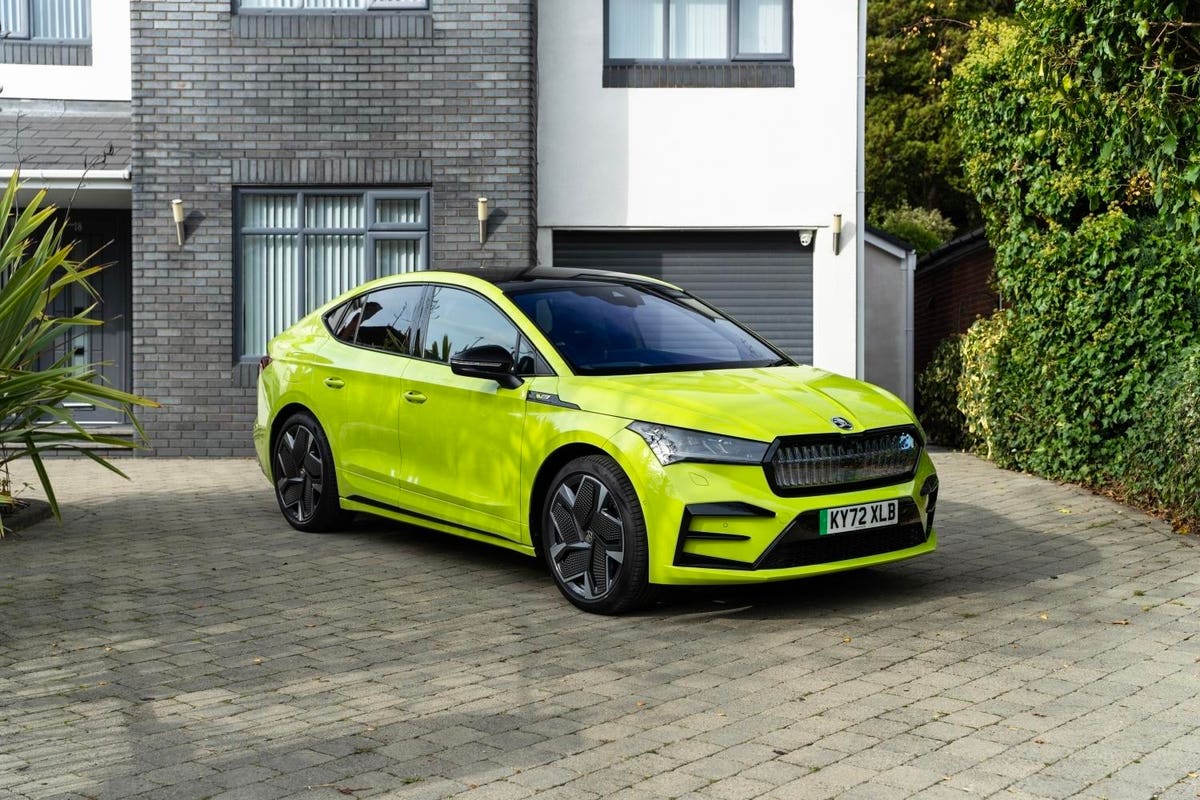Every car brand has its performance variant. With BMW it’s M cars (meaning Motorsport), Audi has RS (standing for RennSport), and Czech brand Skoda has vRS (although it’s RS outside the UK). The vRS name may not be as illustrious as BMW M or Audi RS, but it still implies a racing heritage. It is short for Victory Rally Sport (or Racing Sport), referring to Skoda’s 45 years of success in rallying. So when Skoda adds the vRS lettering to an electric SUV, is it appropriate? I tried the Skoda Enyaq Coupe iV vRS to find out.
The Skoda Enyaq iV set a new benchmark for affordability in electric SUVs when it was launched in 2021. But it majored more on practicality than looks. The Coupe version attempts to improve upon that with a slanty rear. The Coupe name has been rather abused in the last few years. It used to mean a two-door car with a sporty sloping roof at the back, but the two-door aspect appears to have been dropped. Applying the Coupe description to an SUV is also questionable, a bit like adding a spoiler to a bus.
In fact, coupe SUVs frequently look a bit odd (the BMW X6 for example), but the Enyaq iV version is an improvement over its non-Coupe sibling. It reduces the functional appearance without drastically limiting utility. The rear seats don’t noticeably lose headroom. Basic rear luggage space has only dropped from 585 liters to 570 liters, and with the rear seats from 1,710 liters to 1,695 liters, which is still huge. The slope might make some loads a bit trickier, such as a dog cage, but you gain in appearance much more than you lose in practicality. You can even still tow up to 1,400kg braked (or 1,200kg for the single-motor 80 variant).
The racier appearance is presumably why Skoda chose to launch vRS in electric form with the Coupe. Unlike the standard Enyaq iV, there’s no 60 version of the Coupe, just the 80, the 80x and the vRS. The 80 has 201hp and is rear-wheel-drive, the 80x has 261hp with all-wheel-drive, as is the vRS, but with motor output raised to 295hp. That’s a decent amount of power, but this is a 2.4-ton car. So 0-62mph still takes 6.5 seconds. This is quick enough for a big SUV, but not exactly Tesla Model Y Performance territory. In fact, the latter accelerates to 60mph in just over half the time.
You also feel the weight around corners. The Skoda Enyaq Coupe iV is no BMW sports SUV. However, it still has the low center of gravity characteristic of a pure-BEV platform (it uses Volkswagen Group’s MEB), so the body roll is less than you’d expect for a fossil fuel-powered SUV this size. Where the Coupe reigns supreme is munching through motorway miles. It sits very competently on the road at this kind of speed, with the weight is in its favor. Passing a large truck or a sudden sidewind have little effect.
Underlining Skoda’s focus on this car as the vRS flagship is the fact that the “eye-catching” Hyper Green of the test vehicle I drove is the standard paint. The similarly garish orange is a premium extra, as is red, but you can choose black, grey, silver, blue or white as no-cost alternatives. You’re definitely going to get noticed with the basic green. The standard Enyaq iV is now also available in vRS form, and that has Hyper Green as its default color too. Skoda is clearly trying to make a statement.
Volkswagen doesn’t lead the market when it comes to software. The controls in general have a few more conventional elements, with regular steering wheel stalks and buttons that in general feel of higher quality than VW’s ID. cars. While there are separate buttons for window demisting, the rest of the air conditioning is operated via the 13in infotainment screen. The layout and organization is generally quite easy to get used to, with responsive touch sensitivity. But Volkswagen Group recently fired almost its entire software team, and Herbert Diess’s departure last year was purportedly due to the software issues. There continue to be reports of problems with over-the-air updates.
While the Skoda Enyaq Coupe iV isn’t top of the league when it comes to range, it’s certainly competitive. All versions of the Coupe have 82kWh gross battery capacity, 77kWh net. This gives the vRS a decent WLTP range of 324 miles. The 80x provides 322 miles and the single-motor 80 a very commendable 345 miles. Volkswagen Group’s MEB platform is a bit behind Tesla and the Hyundai Motor Group for charging speed, though. The Enyaq iV maxes out at 135kW DC charging, where we’re seeing more cars offer 200kW or more now. I managed 127kW when starting a charge at 20% on a 350kW unit, so at least the specification is fairly accurate.
To test the range, I took the Enyaq iV Coupe on a relatively long run from London to Loughborough and back, a journey of 216 miles. It averaged 3 miles per kWh, which is more like 231 miles of range. However, that was mostly motorway driving and in torrential rain, so in better conditions you’d probably get at least 240 miles, which makes this car more than capable of long-distance driving. What was particularly impressive was that I thought I might make the entire journey in one go, but the sat-nav suggested a quick stop at an IONITY station on the return leg, routing me there and then telling me when I’d charged enough to arrive home with at least 20%. That’s the kind of automated guidance EVs need to soothe range anxiety with those who aren’t that good at planning for themselves.
The Skoda Enyaq Coupe iV vRS isn’t an ultra-fast electric SUV to humble supercars in the same way as the Tesla Model Y Performance or BMW iX M60. That said, the vRS badge has been applied to non-electric cars that weren’t as hot as their BMW M or Audi RS equivalents in the past. There’s still something very likeable about this car. The £54,370 ($69,000) base price is a little more than the Tesla Model Y Long Range, which beats it on performance, range, and luggage space. But the Coupe in general starts around the same price as the Model Y, and costs less than the Volkswagen ID. 5 (the fastback version of the ID. 4), which doesn’t have the same character. So while the Skoda Enyaq Coupe iV vRS won’t outsell the Tesla market leader, it’s a competent family electric SUV, with a little bit of performance flare – even if it isn’t exactly a vRS of racing pedigree.
Read the full article here




